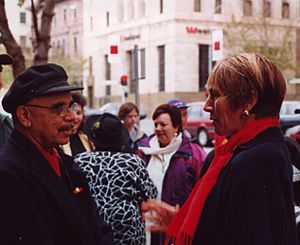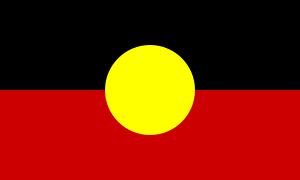Harold Thomas (artist) facts for kids
Quick facts for kids
Harold Joseph Thomas
|
|
|---|---|

Harold Thomas with Jane Lomax-Smith in Adelaide commemorating the 30th anniversary of the Australian Aboriginal flag, 8 July 2001
|
|
| Born | 1947 (age 77–78) Alice Springs, Northern Territory, Australia
|
| Alma mater | South Australian School of Art |
|
Notable work
|
Australian Aboriginal flag |
Harold Joseph Thomas (born 1947), also known as Bundoo, is an Aboriginal Australian artist. He is famous for creating the Australian Aboriginal flag. He designed the flag in 1971 to represent the Aboriginal land rights movement.
In 1995, the flag became an official "Flag of Australia". Harold Thomas owned the copyright for his design. In January 2022, he transferred this copyright to the Commonwealth of Australia (the Australian government). This made the flag freely available for everyone to use.
Contents
Harold Thomas's Early Life and School
Harold Joseph Thomas, or Bundoo, was born in 1947 in Alice Springs, Northern Territory. His father was from the Wombai group, and his mother was from the Luritja group. He was one of 13 children. However, the children did not all grow up together.
When he was seven, Harold was taken from his family. This was part of a sad time in history called the Stolen Generations. Many Aboriginal children were removed from their families by the government. Harold lived at St Francis House in South Australia until he was eleven. Later, he was fostered by Reverend Donald Wallace and his family. He went to Willunga High School and then Pulteney Grammar.
In 1966, at 17, Harold won a scholarship. He went to the South Australian School of Art. He graduated with honours in 1969. He was the first Aboriginal person to graduate from an Australian art school. While studying, he learned watercolor painting. He also became involved in the civil rights movement for Indigenous Australians.
Harold Thomas's Art and Career
In 1970, Harold Thomas became the first Aboriginal person to work at the South Australian Museum. He worked as a survey artist. This job allowed him to see many Aboriginal artworks and objects.
His art style was influenced by famous painters like Caravaggio, Francisco Goya, and Eugène Delacroix.
In 1972, he moved to Humpty Doo, near Darwin. There, he started painting landscapes and wildlife, especially using watercolours. In 2016, his art changed. He began painting scenes of Aboriginal people's first meetings with European settlers. These paintings also showed the conflicts that happened.
In 2016, his painting Tribal Abduction won a big art prize. It showed an Aboriginal baby being taken from its mother by police. This painting was about the Stolen Generations, which Harold himself experienced. It won the Telstra Art Award, worth A$50,000, at the 33rd Telstra National Aboriginal and Torres Strait Islander Art Awards (NATSIAAs).
The Australian Aboriginal Flag
Harold Thomas says he designed the flag in 1970. He wanted it to be a symbol for a protest march. The flag was first flown at a land rights rally on July 9, 1971, in Adelaide, South Australia. It became a symbol for the Aboriginal land rights movement. In 1972, the Aboriginal Tent Embassy in Canberra also started using it.
On July 14, 1995, the flag was made an official "Flag of Australia". In 1997, Harold Thomas went to court to protect his design. The Federal Court and the High Court agreed that he owned the copyright. This meant he had the legal right to control how the flag was used.
In 2010, Harold Thomas had a disagreement with Google. Google wanted to use a picture that included the Aboriginal flag in its logo. Harold Thomas did not allow it because they could not agree on payment. He explained that he allowed free use for groups that helped Aboriginal people, like health or education services. But he charged a fee for businesses that used the flag for money.
Harold Thomas later gave special business rights to three companies. One company could make flags. The other two could put the flag's image on items and clothes. One of these companies, WAM Clothing, sent legal notices to groups like the AFL and NRL. These notices said the groups were using the flag without permission.
On December 21, 2021, Harold Thomas created a digital version of the flag. It was made as a non-fungible token (NFT). An NFT is a unique digital item that shows ownership. This was to celebrate 50 years of the flag.
On January 25, 2022, after three years of talks, Harold Thomas gave the flag's copyright to the Australian government. This deal made the flag free for anyone to use. He hoped this would make all Aboriginal people and Australians feel good about using the flag. In February 2022, it was shared that the government paid A$13.75 million to Harold Thomas for the copyright. They also paid A$6.3 million to two non-Indigenous businesses that had licenses to use the flag.
Other Works by Harold Thomas
In 1972, Harold Thomas drew pictures for a book called Tales told to Kabbarli: Aboriginal legends collected by Daisy Bates. He also illustrated Jagardoo: Poems from Aboriginal Australia (1977) and Kurkali the Lizard (1994), a children's picture book.
From 1973 to 1974, he created and directed a play called Pelicans Dream. In 1995, he was the head of the Northern Territory Stolen Generation Committee.
Awards and Recognition
- 1971: Received an honorary degree in social anthropology from the University of Adelaide.
- 1984: His art was chosen for the first NATSIAA award exhibition.
- 1987: Became the official portrait artist for the Northern Territory Government. His paintings of leaders are displayed at Parliament House, Darwin.
- 2016: Won the Telstra Art Award for his painting Tribal Abduction at the 33rd NATSIAAs.
- 2017: His painting Myal Creek Massacre, about a terrible event in 1838, was a finalist in the NATSIAA Awards.
- 2023: Received an Honorary Doctor of Arts from Charles Darwin University. This was for his important work in fine arts and Aboriginal rights.
Personal Life
Harold Thomas has lived in Humpty Doo, near Darwin, in the Northern Territory since the 1990s.
Selected Art Exhibitions
- 1986: New Works, Framed Gallery, Darwin, Northern Territory
- 1987: Northern Light, Birukmarri Gallery, Fremantle
- 1990: Group exhibition, Balance
- 1990: Views, Visions, Influences, Queensland Art Gallery, Brisbane
- 1991: Prints, at Tandanya, Adelaide, South Australia
- 1991: Prints, at Sydney Opera House
- 1993: 10th NATSIAA exhibition, Museum and Art Gallery of the Northern Territory; his painting "Bungalo Boy" was bought by the museum.


